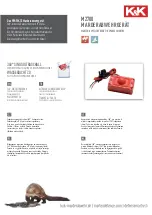
Chapter 8: Downstream Cable Access Modules (DCAMs)
STANDARD Revision 1.0
C4® CMTS Release 8.3 User Guide
© 2016 ARRIS Enterprises LLC. All Rights Reserved.
245
Interleaver Settings
The downstream interleaver helps protect against noise bursts. By interleaving the data, only small pieces of several data
frames are lost as opposed to a larger portion of a single data frame. Reducing the amount of contiguous errors results in a
higher probability that the FEC can correct the losses due to bursts of noise. The more interleaved that the data actually is,
the smaller the amount of data that is lost in any particular data frame; however, increasing the interleaving also increases
the amount of the delay in the transmission of the data.
The table below provides examples of the effects of various interleave depth settings. Taps can be thought of as different
sources of information. The increment determines how much information is taken from each tap; it varies inversely with
the number of taps. The interleaver works with a total of 128 symbols in one group. If there are 128 taps, then each tap
takes one symbol. If there are 16 taps then each one takes 8 symbols. Burst protection values refer to the maximum size in
microseconds of a burst that can be corrected.
Five different versions of the downstream interleaver are available to DOCSIS
®
CMTS operators. The following table shows
the different interleavers that are available, the length of a noise burst that they can protect against and the delay in the
data transmission. Default = 32 taps.
Table 30.
Annex B Downstream Interleavers
Taps
Incre-
ment
64 QAM
256 QAM
Burst Protection
(mSec)
Latency (mSec)
Burst Protection
(mSec)
Latency (mSec)
8
16
5.9
0.22
4.1
0.15
16
8
12
0.48
8.2
0.33
32
4
24
0.98
16
0.68
64
2
47
2.0
33
1.4
128
1
95
4.0
66
2.8
Note: Burst protection is measured in microseconds; latency is measured in milliseconds.
For the EURO-DOCSIS specification, there is only one downstream interleaver setting that is allowed.
















































